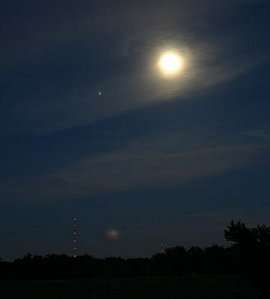Beyond the Fireworks: A Heavenly Sky Show on the 4th of July

This drives astronomers crazy. Every summer, on the one night when millions of Americans are guaranteed to be outside at nightfall, necks craned upward watching the sky, almost no one pays attention to the heavens. It's all fireworks, fireworks, fireworks. Stars and planets don't stand a chance. But this 4th of July is different.
At sunset, just as the fireworks are about to begin, the Moon and Jupiter will pop out of the twilight side-by-side: sky map. These are the brightest objects in the night sky, easily beaming through the flash and smoke of a fireworks display.
Sidewalk astronomers, deploy your telescopes! Here is a wonderful opportunity to show off Jupiter's moons, the Great Red Spot, lunar craters and mountain ranges, and the long creeping shadows at the Moon's day-night divide. Bonus: Point your telescope at blank sky and wait for some fireworks. A good starburst at 25x magnification can be very entertaining.
And don't forget to watch out for spaceships.
During the first week of July, the International Space Station (ISS) passes over many US cities in plain view of evening sky watchers. July 4th is one of the best nights of all. Visit NASA's Sky Watch web site to find out exactly when the station will appear over your hometown.
To see the ISS, simply look up at the appointed time. The station moves slowly across the sky, glowing about as brightly as Jupiter. It does not blink like an airplane or twinkle like a star. It is, in short, unmistakable.
Some of the most important sites of the American Revolution are favored with 4th of July flybys:
At 9:40 p.m. EDT on July 4th, the ISS glides almost directly over Valley Forge, campsite of George Washington's army. Less than a minute later it passes over Philadelphia, where the Declaration of Independence was signed, and then New York City.
In Boston, where the revolution was instigated, and Lexington, where the first shots were fired, the ISS does something special. Instead of passing directly overhead, it dips a little lower, gliding right by the Moon and Jupiter. The time to watch is between 9:40 and 9:41 p.m. EDT.
NASA did not plan these flybys. Chalk it up to good luck and orbital mechanics.
If the space shuttle Discovery launches as planned on July 1st, it will be docked to the ISS on July 4th, boosting the brightness of the ensemble. If you can't see one spaceship through the fireworks, maybe you'll be able to see two.
Source: Science@NASA, by Dr. Tony Phillips





















